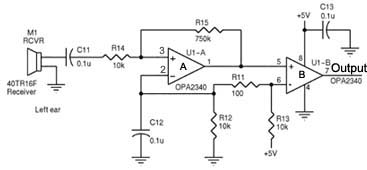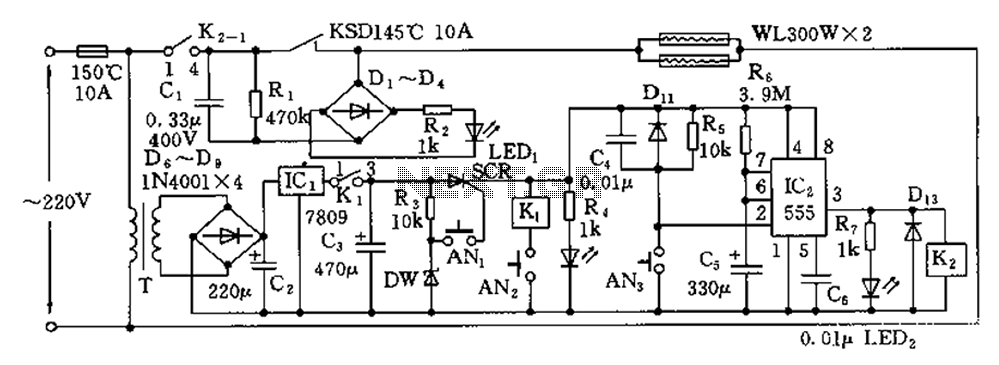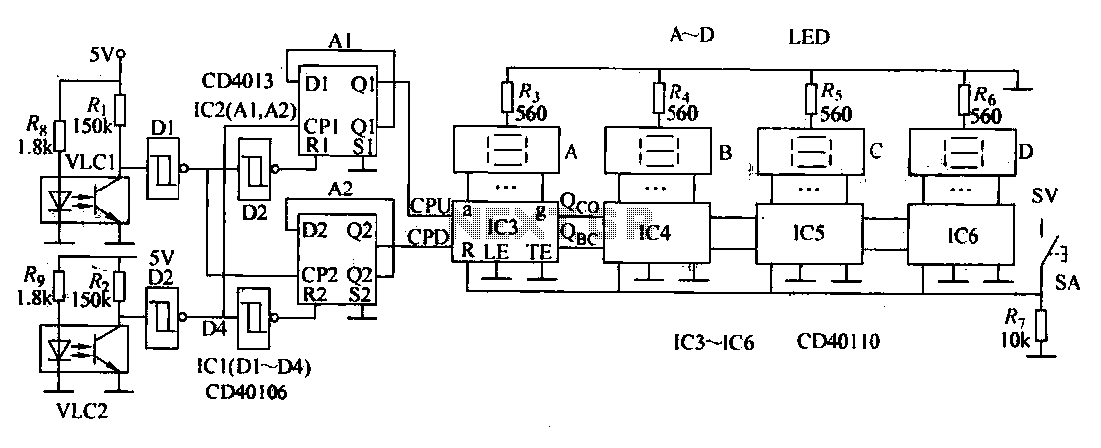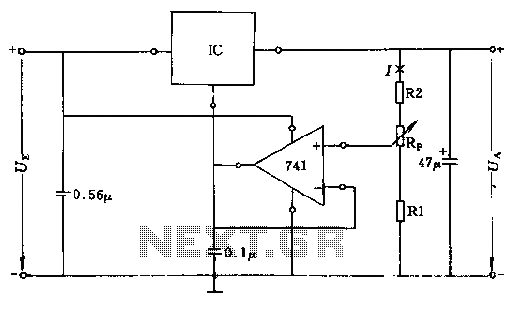
Versatile Multifunction Circuit Uses Only Three Inverters

The versatile circuit can be employed to achieve various functions, including an astable multivibrator, a monostable multivibrator, a switch debouncer, or a frequency discriminator. Inverters U1a and U1b are configured as a latch. When the input voltage (VIN) is high, the output voltage (VOUT) will also be high. Due to regenerative feedback through resistor R2, VOUT remains high until a reset condition occurs or power is removed. While VOUT is high, capacitor C1 charges through resistor R3. The output voltage of inverter U1c remains high until the voltage on C1 surpasses the high threshold (VTH) of U1c. At this point, the output voltage of U1c transitions low. A low output voltage from U1c resets the latch via diode D1. Once the latch is reset, VOUT goes low, and C1 discharges through R3. When the voltage on C1 falls below the low threshold (Vt1) of U1c, its output voltage returns high, restoring the circuit to its original state. This circuit has a natural period (T = t1 + t2), consisting of a high output lasting t1 seconds and a low output lasting t2 seconds. During the entire period T, the circuit cannot be retriggered. The output pulse width (t1) is determined as follows: if VIN is a signal with a period TIN that is greater than T, VOUT will generate a pulse train. In this scenario, VOUT will have a period equal to TIN and a pulse width of t1. The duty cycle of VOUT can be adjusted by varying TIN. Conversely, if VIN has a period TIN much shorter than T, the circuit will oscillate continuously with period T. If T falls within the audible range and is used to drive a speaker, unique sounds can be produced depending on TIN. During its natural period T, the circuit will not respond to any input. An effective switch debounce function can be achieved by ensuring T exceeds the switch bounce time. The same characteristics render the circuit useful for generating a reset pulse. Connecting VIN to VDD allows the circuit to function as an astable multivibrator with an output period of T. When VIN is connected to a signal that remains high for a duration longer than T, a gated astable multivibrator is created. The number of pulses generated will depend on the duration VIN remains high compared to T. To customize the duty cycle of VOUT, steering diodes and an additional resistor can be incorporated. In this configuration, t1 is calculated using R3C1 in the time constant, while t2 is determined using R4C1. The duty cycle is defined as:
This circuit design effectively utilizes inverters to create versatile applications, allowing for multiple configurations depending on the input signal characteristics. The incorporation of regenerative feedback ensures that the circuit maintains its state until explicitly reset, providing stability in its operation. The timing components, specifically R3, R4, and C1, play crucial roles in defining the output characteristics, including pulse width and duty cycle, which can be tailored to specific application requirements.
When used as an astable multivibrator, the circuit continuously oscillates, producing a square wave output. The frequency of oscillation is determined by the values of the resistors and capacitor in the timing network. In contrast, when configured as a monostable multivibrator, the circuit generates a single pulse in response to a triggering input, making it suitable for applications such as switch debouncing or generating reset signals.
The addition of steering diodes allows for modulation of the duty cycle, enabling more complex waveform generation. The careful selection of resistor and capacitor values can achieve desired timing characteristics, facilitating a range of applications from audio signal generation to precise timing functions in digital circuits.
Overall, the circuit's flexibility and adaptability make it a valuable component in various electronic designs, capable of fulfilling multiple roles with minimal additional components.The versatile circuit shown can be used to realize several different circuit functions ”an astable multivibrator, a monostable multivibrator, a switch debouncer, or a frequency discriminator ( Fig. 1 ). Inverters U1a and U1b are connected as a latch. When the input voltage (VIN) is high, the output voltage (VOUT) will go high. Due to the regenera tive feedback through resistor R2, VOUT will remain high until a reset condition occurs or power is removed. While VOUT is high, capacitor C1 is charged through R3. The output voltage of inverter U1c is high until the voltage on C1 exceeds the high threshold (VTH) of U1c.
At this time, the output voltage of U1c will go low. A low voltage at the output of U1c will reset the latch through diode D1. With the latch reset, VOUT will be low and C1 will discharge through R3. When the voltage on C1 goes below the low threshold (Vt1) of U1c, it`s output voltage will go high. The circuit is now back to it`s original state. This circuit has a natural period (T= t1 + t2) consisting of a high output that lasts for t1 seconds and a low output that lasts for t2 seconds ( Fig. 2 ). During the entire time period T, the circuit can not be retriggered. The output pulse width (t1) is determined as follows: Referring to Figure 1, if VIN is a signal having a period TIN that`s larger than T, VOUT will be a pulse train.
In this case, VOUT will have a period equal to TIN and a pulse width equal to t1. The duty cycle of VOUT can therefore be adjusted by changing TIN. In the case where VIN has a period TIN that`s much shorter than T, the circuit will continuously oscillate with period T. If T is in the audible range and used to drive a speaker, some unique sounds can be generated depending on TIN.
During its natural period T, the circuit won`t respond to any input. An effective switch debounce function can be achieved by making T longer than the switch bounce time. The same characteristics make the circuit useful for generating a reset pulse. Connecting VIN to VDD will cause the circuit to function as an astable multivibrator with an output period of T.
Connecting VIN to a signal that is high for a time longer than T creates a gated astable multivibrator. The number of pulses generated will depend on how long VIN is high compared to T. To customize the duty cycle of VOUT, steering diodes and a second resistor can be added, as shown in Figure 3.
For the circuit in Figure 3, t1 is calculated using R3C1 in the time constant. To calculate t2, R4C1 is used. The duty cycle is defined as: 🔗 External reference
This circuit design effectively utilizes inverters to create versatile applications, allowing for multiple configurations depending on the input signal characteristics. The incorporation of regenerative feedback ensures that the circuit maintains its state until explicitly reset, providing stability in its operation. The timing components, specifically R3, R4, and C1, play crucial roles in defining the output characteristics, including pulse width and duty cycle, which can be tailored to specific application requirements.
When used as an astable multivibrator, the circuit continuously oscillates, producing a square wave output. The frequency of oscillation is determined by the values of the resistors and capacitor in the timing network. In contrast, when configured as a monostable multivibrator, the circuit generates a single pulse in response to a triggering input, making it suitable for applications such as switch debouncing or generating reset signals.
The addition of steering diodes allows for modulation of the duty cycle, enabling more complex waveform generation. The careful selection of resistor and capacitor values can achieve desired timing characteristics, facilitating a range of applications from audio signal generation to precise timing functions in digital circuits.
Overall, the circuit's flexibility and adaptability make it a valuable component in various electronic designs, capable of fulfilling multiple roles with minimal additional components.The versatile circuit shown can be used to realize several different circuit functions ”an astable multivibrator, a monostable multivibrator, a switch debouncer, or a frequency discriminator ( Fig. 1 ). Inverters U1a and U1b are connected as a latch. When the input voltage (VIN) is high, the output voltage (VOUT) will go high. Due to the regenera tive feedback through resistor R2, VOUT will remain high until a reset condition occurs or power is removed. While VOUT is high, capacitor C1 is charged through R3. The output voltage of inverter U1c is high until the voltage on C1 exceeds the high threshold (VTH) of U1c.
At this time, the output voltage of U1c will go low. A low voltage at the output of U1c will reset the latch through diode D1. With the latch reset, VOUT will be low and C1 will discharge through R3. When the voltage on C1 goes below the low threshold (Vt1) of U1c, it`s output voltage will go high. The circuit is now back to it`s original state. This circuit has a natural period (T= t1 + t2) consisting of a high output that lasts for t1 seconds and a low output that lasts for t2 seconds ( Fig. 2 ). During the entire time period T, the circuit can not be retriggered. The output pulse width (t1) is determined as follows: Referring to Figure 1, if VIN is a signal having a period TIN that`s larger than T, VOUT will be a pulse train.
In this case, VOUT will have a period equal to TIN and a pulse width equal to t1. The duty cycle of VOUT can therefore be adjusted by changing TIN. In the case where VIN has a period TIN that`s much shorter than T, the circuit will continuously oscillate with period T. If T is in the audible range and used to drive a speaker, some unique sounds can be generated depending on TIN.
During its natural period T, the circuit won`t respond to any input. An effective switch debounce function can be achieved by making T longer than the switch bounce time. The same characteristics make the circuit useful for generating a reset pulse. Connecting VIN to VDD will cause the circuit to function as an astable multivibrator with an output period of T.
Connecting VIN to a signal that is high for a time longer than T creates a gated astable multivibrator. The number of pulses generated will depend on how long VIN is high compared to T. To customize the duty cycle of VOUT, steering diodes and a second resistor can be added, as shown in Figure 3.
For the circuit in Figure 3, t1 is calculated using R3C1 in the time constant. To calculate t2, R4C1 is used. The duty cycle is defined as: 🔗 External reference





